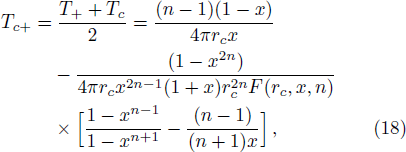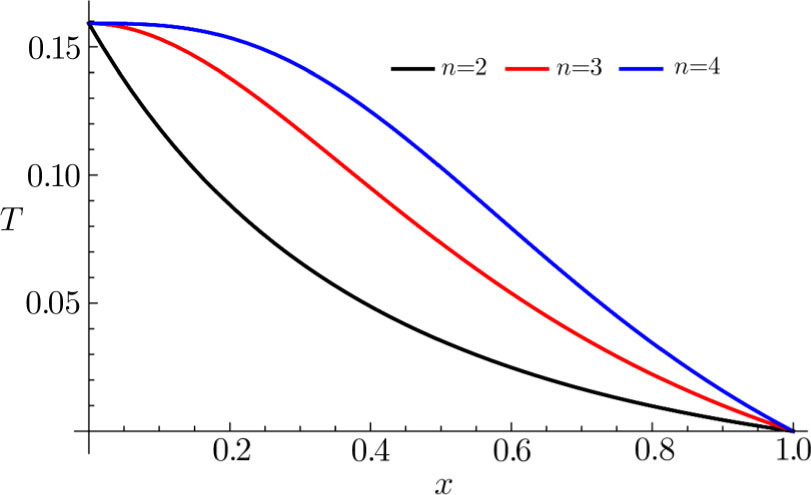† Corresponding author. E-mail:
Supported in part by the National Natural Science Foundation of China under Grant No. 11475108
From a new perspective, we discuss the thermodynamic entropy of (n+2)-dimensional Reissner-Nordström-de Sitter (RNdS) black hole and analyze the phase transition of the effective thermodynamic system. Considering the correlations between the black hole event horizon and the cosmological horizon, we conjecture that the total entropy of the RNdS black hole should contain an extra term besides the sum of the entropies of the two horizons. In the lukewarm case, the effective temperature of the RNdS black hole is the same as that of the black hole horizon and the cosmological horizon. Under this condition, we obtain the extra contribution to the total entropy. With the corrected entropy, we derive other effective thermodynamic quantities and analyze the phase transition of the RNdS black hole in analogy to the usual thermodynamic system.
Black holes are exotic objects in the theory of classical and quantum gravity. Even more surprising is their connection with the laws of standard thermodynamics. Since black hole thermodynamics is expected to play a role in any meaningful theory of gravity, therefore it will be a natural question to ask whether the thermodynamic properties of black holes are modified if higher dimensional corrections are incorporated in the Einstein-Hilbert action. One can expect a similar situation to appear in an effective theory of quantum gravity, such as string theory.
Black holes in different various dimensional sapcetime with different geometric properties have been drawing many interests. Many physical properties of black holes are related to its thermodynamic properties, such as entropy, Hawking radiation. Recently, the idea of including the variation of the cosmological constant Λ in the first law of black hole thermodynamics has attained increasing attention.[1–25] Comparing the thermodynamic quantities in AdS black holes with those of conventional thermodynamic system, the P-V criticalities of these black holes have been extensively studied. It is shown that the phase structure, critical exponent and Clapeyron equation of the AdS black holes are similar to those of a van der Waals liquid/gas system.
As is well known, de Sitter black holes can have both the black hole event horizon and the cosmological horizon. Both the horizons can radiate, however their temperatures are different generally. Therefore, the whole de Sitter black hole system is thermodynamically unstable. We also know that the two horizons both satisfy the first law of thermodynamics and the corresponding entropies both satisfy the area law.[26–28] In recent years, the studies on the thermodynamic properties of de Sitter space have aroused wide attention.[26–39] In the early inflation epoch, the universe is a quasi-de Sitter spacetime. If the cosmological constant is the dark energy, our universe will evolve to a new de Sitter phase.
Because the two horizons are expressed by the same parameters: the mass M, electric charge Q and the cosmological constant Λ, they should be dependent each other. Taking into account of the correlations between the two horizons is very important for the description of the thermodynamic properties of de Sitter black holes. Previous works, such as Refs. [40–54], considered that the entropy of the de Sitter black holes is the sum of the black hole entropy and the entropy of the cosmological horizon. Based on this consideration, the effective thermodynamic quantities and phase transition are analyzed. It shows that de Sitter black holes have the similar critical behaviors to those of black holes in anti-de Sitter space. However, considering the correlation or entanglement between the event horizon and the cosmological horizon, the total entropy of the charged black hole in de Sitter space is no longer simply S = S+ + Sc, but should include an extra term from the contribution of the correlations of the two horizons.[55–57]
In this paper, we study the (n + 2)-dimensional Reissner-Nordström-dS black hole by considering the correlation of the black hole horizon and the cosmological horizon. In Sec.
The line element of the (n + 2)-dimensional RNdS black hole is given by[26]














According to f(r+) = f(rc) = 0, one can derive



From T+ = Tc, we can get




When the cosmological constant satisfies Eq. (
 | Fig. 1. (Color online) The temperature of lukewarm black hole as function of x for different spacetime dimensions. We have set rc = 1. |
As is depicted in Fig.
The thermodynamic quantities of (n + 2)-dimensional RNdS black hole satisfy[44–45]


The effective temperature, the effective pressure and the effective electric potential are respectively



For a system composed of two subsystems, the total entropy should be the simple sum of the entropies of the two subsystems if there is no interactions between them. When correlation exists between the two subsystems, the total entropy should contain an extra contribution coming from the correlations between the two subsystems. Considering the correlation between the two horizons, we conjecture that the entropy of the (n + 2)-dimensional RNdS black hole should take the form of

Substituting Eqs. (



When the temperatures of the two horizons are the same, the charge Q satisfies Eq. (



When the two horizons have the same temperature, we think the effective temperature of the system should have the same value, namely








 | Fig. 2. (Color online) (a) depicts f(x) as functions of x for (n + 2)-dimensional RNdS black hole. (b) depicts the whole entropy S of the RNdS black hole in different dimensions. We have set rc = 1. |
 | Fig. 3. (Color online) The effective temperature as functions of x. (a) depicts Teff at fixed Q = 0.05. (b) depicts Teff at fixed n = 3. We have set rc = 1. |
As is shown in Fig.
In analogy to the van der Waals liquid/gas system, one can analyze the black hole thermodynamic system. One can derive the critical exponent, Ehrenfest’s equations. However, the de Sitter black hole cannot be in thermodynamically equilibrium state in the usual sense due to the different temperatures on the two horizons. From Eq. (
 | Fig. 4. (Color online) The effective temperature and the effective heat capacity as functions of x for different Φeff = 0.1, 0.2, 0.3 with fixed n = 2. We have set rc = 1. |
When n = 2, the effective potential is


The effective heat capacity can be defined as

The analog of volume expansion coefficient and analog of isothermal compressibility are given by

We now exploit Ehrenfest’s scheme in order to understand the nature of the phase transition. Ehrenfest’s scheme basically consists of a pair of equations known as Ehrenfest’s equations of first and second kind. For a standard thermodynamic system these equations may be written as


From the Maxwell’s relations,








In this paper, we first propose the condition under which the black hole horizon and the cosmological horizon have the same temperature for the RN-dS black hole. We think that the entropy of these black holes with multiple horizons is not simply the sum of the entropies of every horizon, but should contain an extra contribution from the correlations between the horizons. On the basis of this consideration, we put forward the expression of the entropy. According to the effective first law of black hole thermodynamics, we can derive the effective temperature Teff, the effective pressure Peff and the effective potential Φeff. In the lukewarm case, the temperatures of the two horizons are the same. We conjecture that the effective temperature also takes the same value. According to this relation, we can obtain the differential equation for f(x). Considering the reasonable boundary condition: f(0) = 0, we can solve the differential equation exactly and obtain the f(x).
In Sec.
We anticipate that study on the thermodynamic properties of the black holes in de Sitter space can shed light on the classical and quantum properties of de Sitter space.
| [1] | |
| [2] | |
| [3] | |
| [4] | |
| [5] | |
| [6] | |
| [7] | |
| [8] | |
| [9] | |
| [10] | |
| [11] | |
| [12] | |
| [13] | |
| [14] | |
| [15] | |
| [16] | |
| [17] | |
| [18] | |
| [19] | |
| [20] | |
| [21] | |
| [22] | |
| [23] | |
| [24] | |
| [25] | |
| [26] | |
| [27] | |
| [28] | |
| [29] | |
| [30] | |
| [31] | |
| [32] | |
| [33] | |
| [34] | |
| [35] | |
| [36] | |
| [37] | |
| [38] | |
| [39] | |
| [40] | |
| [41] | |
| [42] | |
| [43] | |
| [44] | |
| [45] | |
| [46] | |
| [47] | |
| [48] | |
| [49] | |
| [50] | |
| [51] | |
| [52] | |
| [53] | |
| [54] | |
| [55] | |
| [56] | |
| [57] | |
| [58] | |
| [59] | |
| [60] |

